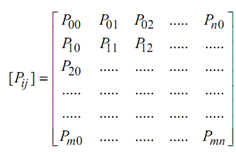Bezier Surface:
A tensor product Bezier surface is refers to an extension of the Bezier curve in two parametric directions u and v.
A Bézier surface is described by a two-dimensional set of control points pi,j, where i is in the range of 0 and m, and j is in the range of 0 and n. Therefore, in this case, we have m + 1 rows and n + 1 columns of control points and the control point on the i- th row and j-th column is denoted by pi,j. Note down that we have (m + 1) (n + 1) control points in total.

An orderly set of data or control points [Pij] is utilized to build-up a topologically rectangular surface as illustrated in Figure.
The surface equation of a Bézier surface indicated by m + 1 rows & n + 1 columns of control points :

0 < u < 1, 0 < v < 1
where Bmi (u) and Bn,j (v) are the i-th & j-th Bézier basis functions in the u- & v- directions, respectively. Recall from Bézier curves, these basis functions are described as follows :
Bm ,i (u) = (m! / ( i!(m - i)! )) ui (1 - u)m-i
Bn ,j (u) = (n! / ( j!(n - j)! )) vi (1 - v)n-i
P (u, 0) is any point on the surface and Pij are control points. These points make the vertices of control or characteristic polyhedron as illustrated by dotted lines in Figure . Since Bm,i (u) and Bn,j (v) are degree m and degree n functions, we will say this is a Bézier surface of degree (m, n). The set of control points is generally referred to as the Bézier net or control net. Note down that parameters u and v are in the range of 0 and 1 and therefore a Bézier surface maps the unit square to a rectangular surface patch.